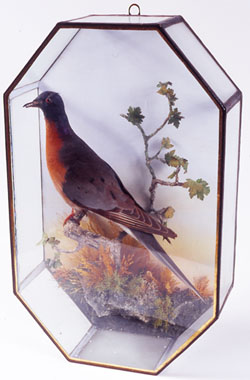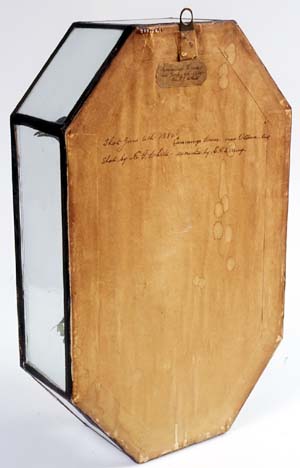 |
Victorian ornament consisting of a preserved and mounted passenger pigeon; Material: glass, lead; Ottawa, Ontario; Height 51.9 cm, Depth 12.9 cm, Width 31.7 cm.
CMC 995.26.1
There was a time when the skies of Southern Canada were darkened by huge flocks of migrating passenger pigeons. In 1866, one flock that appeared in Ontario measured one mile wide by 300 miles long and contained an estimated 3.5 billion birds. It took 14 hours for them to pass overhead. Passenger pigeons were then the most numerous birds in the world, but by 1900 they were extinct in the wild, and the last one in captivity died in 1914. Low reproduction rates, destruction of the hardwood forests that provided shelter and food, and intensive hunting by man account for this remarkable collapse.
|
 |
Back of Display case with text; Shot June 6th 1884 - Cummings woods near Ottawa, Ont. Shot by E.G White - Mounted by S.H. Herring.
CMC 995.26.1
One small episode in the story occurred on Friday June 6, 1884 when a field naturalist, Ed. F.G. White, took his gun and headed off to Cummings Woods near Ottawa to hunt. He shot at least one passenger pigeon which ultimately came into the hands of S.H. Herring who mounted it for display. Eventually the beautifully-prepared bird was acquired from its original owner by Alfred (Fred) Eugene Bourguignon, an Ottawa businessman and ornithologist and a long-time member of the Ottawa Field Naturalists' Club. The treasured ornamental specimen was given to the Canadian Museum of Civilization by Mr. Bourguignon's widow, Marie J. (Flynn) Bourguignon, in his memory.
|

![]()


![]()
